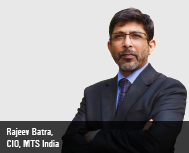
CIOTechOutlook >> Magazine >> December - 2015 issue
Benefit Bottom Lines with Big Data Analytics
By
 Headquartered in Gurgoan, Haryana, MTS India is a telecommunications company that provides services like Data, Smartphones, Voice and Value Added Services.
Headquartered in Gurgoan, Haryana, MTS India is a telecommunications company that provides services like Data, Smartphones, Voice and Value Added Services. Since the era of computing began, data has come a long way. In the past, data was limited to specific and well-defined zones. Over the years, though, a tectonic shift in data generation patterns and sources has occurred, whereby boundaries between machines and humans churning data have crumbled.
While disparate forms of data are generated, these are broadly classified into two categories: structured and unstructured. Whereas structured data has existed since the inception of computing, unstructured data has stormed the stage in recent times and is rising rapidly. The measuring parameters for data are no longer in Terabyte, Petabyte or Exabyte, having been overtaken by Zettabyte. But with predictions of 50 billion connected devices in the next 3-5 years, this parameter may be superseded by Domegemegrottebyte, 12 zeros added to Zettabyte.
Therefore, the world may soon be witness to a hyper-exponential growth of data and it may not be incorrect to state that data availability will be akin to a natural resource, such as air and water.
Decoding an Ocean of Data
In order to extract business and lifestyle value out of this constantly increasing data, there is dire need to have a medium that can translate an ocean of information into relevant and meaningful propositions or insights. To achieve the above, the voluminous data generated by multiple sources, both active and passive, need to be analyzed with speed, as any delay causes decay in analytical value of data, besides decreasing the competitive relevance of the same for an individual or organization.
In the goal towards achieving smart living, this translates into an individual’s enhanced ease and quality of life, including increase in life expectancy, as health-related vital parameters can be proactively monitored and any straying from the normal can be addressed in time to avoid deterioration in health.
Technology corridors have been hearing transformational terms and buzzwords such as Smart Cities, SMAC (Social Mobility Analytics and Cloud), Big Data, Internet of Things (IoT), SDN (software-defined networks), NFV (network function virtualization) and so on. Given the realization of immense business value through such technology proliferation, these concepts are moving rapidly into the practical realm. The top-view distinctly unveils an intrinsic inter-linkage between these technologies to realize their full potential. The adoption of SMAC is further fuelled by ease in availability of applications, which thrive on the fundamental premise of social connect, mobility, Cloud and analytics.
Furthermore, IoT promises to expand the universe of connectivity to include systems and devices, which hitherto have existed in our environment and were controlled through physical touch, visual, manual interaction or at the M2M (machine-to-machine) level. IoT will require enabling intelligence on these systems and devices so that they may get aligned with behavioural, norm or usage patterns of the user either for convenience, efficiency or for services that are unimaginable in isolated mode.
Analytics to Drive Transformation
Needless to say, this eco-system will be realized via a comprehensive level of IT automation working in tandem, which essentially requires a cloak of cyber security to ensure the systems operate without any disruptions or are not compromised in any way.
It’s evident that billions of things connected, communicating and generating data will require almost continuous need of networking, computing and storage supply to keep pace with the volume and flow of data. NFVs and SDNs are two independent concepts but complementary in nature, and the overall infrastructure will gravitate towards these configurations to satiate an unending demand for computing, Cloud-based applications availability and communication infrastructure that IoT will demand.
Besides providing analytics and relevant information, Big Data-based Analytics will open new business models or transform existing businesses and the way one conducts market-centric activities. It will ensure enhanced accuracy for products and services being launched in hyper-competitive segments such as telecom, media, e-Tailing, insurance, banking, agriculture, etc., since marketing and sales can use Big Data for predictive analysis, which will help in designing fewer products and services that have a much higher probability of success than large numbers churned out presently with the majority not leading to any returns.
In cognitive format, Big Data may be a game-changer in transforming how artificial intelligence is perceived. The applications out of this configuration may lead to cures for several life-threatening and dreaded ailments such as cancer, AIDS and others. The only caveat will be that people’s lives may become so dependent on personalized data available in the connected world that privacy may become passé and any security breach could lay one’s life bare to the world at large, till the breach and its impact are contained.
But that’s the price humankind may have to pay for the magnitude of benefits this technology brings to human life.
CXO Insights
LMS - The Upcoming 'Force Multiplier'
By Manoj Tandon, CEO, The Manoj Tandon & Company
Multi-Brand Loyalty Programs Boost Consumer...
By Rahul Rana, COO, PAYBACK India Pvt Ltd.
Real-Time Engagement (RTE) Technology and its...




